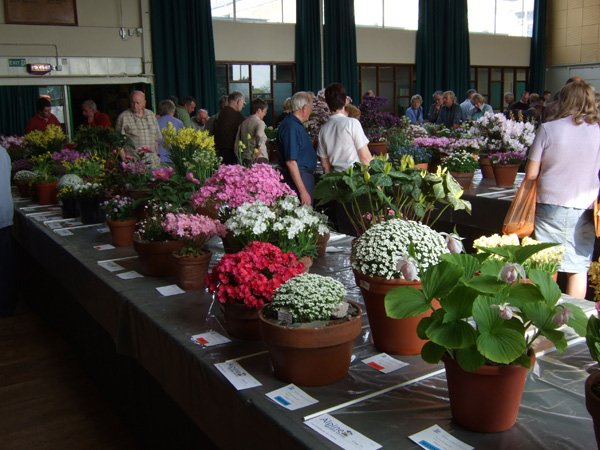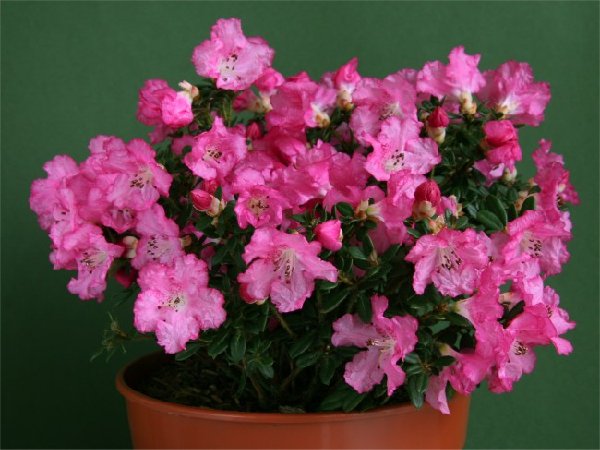Midland AGS Show, 2007
 The day started bright and clear, a cool easterly breeze ensured that it would remain that way as I made my way up the M5 to Solihull not knowing quite what to expect.
The day started bright and clear, a cool easterly breeze ensured that it would remain that way as I made my way up the M5 to Solihull not knowing quite what to expect.
A year with no cold during the winter but plenty of rain had caused problems for plants and growers alike. Upon entering the hall all of my fears were lost as the range of colours and diversity of plants that greeted me was amazing. According to the official figures the entries were down on last years record numbers but this was difficult to believe by observation.
 In a show of this quality surprisingly no AGS medals were awarded, I can only assume that the exhibitors had chosen to save their best plants for other classes. The fact that the standard was high became obvious with no less than five plants placed before the judges for the best plant in a 19 cms pot. The voting was always close with never any more than one or two votes separating the exhibits. Finally, after much debate, it was decided to give the award to a beautiful pan of Rhododendron dendrocharis grown by Diane Clement. Always an attractive plant but made even more striking by virtue of its darker than usual flowers. Just missing out this time was Lionel Clarkson’s superb example of Dodecatheon sooke variety which caused much debate among the judges as to the correct species. Although exhibited as hedersonii the general opinion was that it is more likely to be a form of pulchellum. Such is the joy of showing, but this did not detract from being awarded a Certificate of Merit for what was a first class example of a genus seen all too rarely at our shows.
In a show of this quality surprisingly no AGS medals were awarded, I can only assume that the exhibitors had chosen to save their best plants for other classes. The fact that the standard was high became obvious with no less than five plants placed before the judges for the best plant in a 19 cms pot. The voting was always close with never any more than one or two votes separating the exhibits. Finally, after much debate, it was decided to give the award to a beautiful pan of Rhododendron dendrocharis grown by Diane Clement. Always an attractive plant but made even more striking by virtue of its darker than usual flowers. Just missing out this time was Lionel Clarkson’s superb example of Dodecatheon sooke variety which caused much debate among the judges as to the correct species. Although exhibited as hedersonii the general opinion was that it is more likely to be a form of pulchellum. Such is the joy of showing, but this did not detract from being awarded a Certificate of Merit for what was a first class example of a genus seen all too rarely at our shows.
On walking round the show I, and a number of others, were attracted by an interesting Caucasian Campanula. Growing from a central tap root Campanula dzaaku is not an easy plant to maintain, particularly during the dormant winter months. This delightful plant had three inch prostrate stems supporting the pale blue bell shaped flowers. Bought from a specialist nursery about three years ago, provided it can be maintained, Campanula dzaaku should make a welcome new addition to the range of early flowering campanulas.
With all the spectrum of colours on the benches one could have been forgiven for not noticing a particular viola in class 91. Viola pachyrrhiza is a very charming small plant recently introduced from Iran at the same time as V. spathulata. It differs from the latter in the smaller flowers but neater rosettes. As to cultivation, if you can obtain one, the advice from the exhibitor is to grow it like a Dionysia.
We are all familiar with Fritillaria liliacea but I cannot remember seeing one in such superb condition as George Youngs entry in Class 17 grown from seed sown in 1990 so patents is required. It too was considered worthy of a Certificate of Merit.
Finally with all the “flower power” around, I must mention Cecilia Coller’s Cheilanthes wootonii, a dry land fern that has been one of the mainstays of the fern classes for many years. What caught my notice was the superb condition of this plant. The newly emerged fronds radiated a subtle brilliance to rival many of the flowering plants. It was one of those fortunate occurrences that sometime occur where the plant was at its peak precisely on the day of the show.
